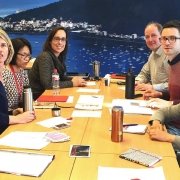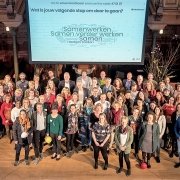School as Multifunctional Community Resource
Excerpt
In the context of rapid changes in society schools face the problem of how to provide services in a way that promotes lifelong learning, social cohesion and sustainable development for individuals and communities while being efficient and accountable at the same time. The impact of the financial crises, declining number of students and uncertainty about rural development in general has put small rural schools in Latvia in a challenging situation. Since 2009 the initiative has been implemented to support schools to develop into multi-functional community centres by expanding their functions and reconsidering their role in local communities.
Narrative, origins and objectives of the initiative
What kind of project is this? Please give a short description (summary) of it.
Since 2009, when a global financial crisis hit Latvia and existence of schools (especially schools with less than 100 students in rural areas), the initiative “Schools as Community Development Centres” has been implemented, embracing approximately 100 schools from all regions of Latvia. The initiative was intended as immediate support to schools in order to maintain their functioning, but it has also been very instrumental in two other ways: 1) developing models for a new approach to the role and functions of the rural schools in Latvia and 2) as a case for theoretical and empiric studies of transformations in the schools and communities as well as in their relationships. During the programme they have provided funding and capacity-building opportunities for over 100 schools.
Please tell us why, in general, this project is considered a successful one?
Local communities', schools' and municipalities’ understanding of the role and potential of school as a multi-functional community centre (diversifying activities within schools based on needs assessment, organizing activities in coordination with other local agents, more efficient use of resources etc.) has deepened. Locals are becoming more active demand drivers for a school in their community. Schools in turn have become aware of the role of local people’s needs in expanding the activities of a school and are able to provide a suitable offer for each specific area and community. Local governments have gained assurance based on school activities that a small rural school nowadays can work differently so that, unlike the traditional school model, the school does not only perform formal education functions in a municipality.
And why would you consider it a grass-roots initiative?
As a result of the global financial crisis there was a wave of small schools closing down in Latvia in 2008-2009. The foundation was approached by municipalities and schools to develop a programme to save schools. The development programme gave local school-municipality tandems a lot of autonomy to implement their own approach.
What challenges needed to be solved in this project?
Despite the fact that, historically, schools in Latvia have been the centre of local communities, this experience had been lost and had to be re-introduced. There is a perception in society that school is for formal education; in many cases parents are rather reluctant to go to school as it may entail unpleasant conversations. Other community members do not see any reason why they have to go to the school. On the other hand, regulations and practice in schools are based on the assumption that school is for teachers and students. Access to premises and infrastructure is restricted according to direct teaching-learning process needs and is entirely controlled by the school administration and teachers. As a result, the local community has little information about school, resources are not used effectively and in a situation of scarce finances it seems very expensive to maintain a school.
Is this initiative based on any particular theoretical framework? Which one?
Although different terms are used, such as community schools, full-service schooling, extended schools, integrated services, they share common features and roles in the community – they are "full service neighbourhood hubs where the school and partners from across the community come together to ensure children and families have what they need to be successful - in school and in life” (Geiser et al, 2013). In that sense community schools come very close to the concept of learning communities described by the Canadian educationalist Ron Faris as “neighbourhoods, villages, towns, cities or regions that explicitly use lifelong learning as an organizing principle in order to promote collaboration of their civic, economic, public, voluntary and education sectors to enhance social, economic and environmental conditions on a sustainable, inclusive basis”.
(Appendix) Is your intervention standing on its own or is it a part of a bigger and more holistic approach?
The initiative itself was a rather holistic one and was implemented in a large number of communities.
Please describe the group(s) intended as beneficiaries of this initiative
Why has this group (have these groups) been chosen?
Schools with less than 100 students were at risk of being closed, so both schools and municipalities owning them were motivated to change the ways they operated these schools. As a local community centre has proven value even in the smallest of communities, they were chosen to maintain and widen services in lifelong learning and beyond.
Could you please tell us something about the relative size of the (of each) target group, within the school/university population, region and/or country?
At the time of starting the programme about one third of schools in Latvia had less than 100 students and were thus at risk of closing. Most of them, 255 to be exact, were situated in small settlements where no other education services were available for locals nearby.
Which social characteristics are taken into account and what is the geographical area covered?
The initiative was implemented throughout the entire country, in small settlements. Local community members in these settlements have little to no access to services offered by the local initiative before the programme started. At the same time there was a clearly established need for activities offered by the programme later.
On which level is the project implemented?
National level
Please describe the political and socio-economic factors that you believe have been important enablers for your initiative
Did the initiative have political support?
From the start political support was ensured on the level of municipality as a response to national policy on closing small schools. The national policy support was won through successful implementation.
How did it fit with local, regional or national policies?
Local and regional policies generally focus on community development. In Latvia, like in many other places in Europe, it is crucial to keep small local communities alive and ensure that there is a next generation by making the settlements more attractive. For families with children the existence of a local school is always a factor.
Who are the stakeholders supporting the initiative?
The foundation was the main stakeholder offering funding and professional support. Local implementation was supported by municipalities and schools in the first place, the teachers, parents and students themselves, and the whole local community as the ultimate target group.
Are there particular demographic changes present that are influencing the project?
Due to a decreasing number of births and migration from the country and the countryside, the number of students in rural schools has declined.
What is the institutional strategy and culture of the (educational) organization?
The approach of the initiative was to make schools, teachers and education systems ready, willing, capable and skillful to change their habits, approaches, attitudes etc. This is done in order to see students, their families and communities in a holistic way. If there is a balance between funding for physical improvements and developing human resources, the school becomes a learning and changing organisation that provides a key for success. This does not happen if the change is introduced by individual teachers only.
To what extent does the initiative have an influence on institutional policy (or potential influence) of the (educational) organization?
Significant changes have started in the organizational culture of schools themselves as they are starting to reconsider their role in the local community, discovering opportunities to engage in multifaceted cooperation as well as realizing the benefits from such activities for formal learning, fulfilling educational goals and mission.
(Appendix) Is there public support for your initiative and the issue it addresses?
It was necessary to make local communities understand that the benefits of maintaining a school that is transformed into a community learning centre is worth its costs. Participation at the centres clearly show community support.
(Appendix) What other factors do you think have been important for the success of this initiative?
Collaboration between schools and municipalities to exchange experiences and build on each other’s success as well as learning from failure.
Please describe the overall initiative design and the methods and tools used to reach the goals
Please describe the specific activities carried out.
The programme had two main activity strands:
- providing funding for local activities/sub-projects in the schools/communities committed to re-profiling into multi-functional learning community centres;
- building capacity of local change agents: ongoing support, mentoring, offering know-how, promoting exchange of experiences etc. through seminars, conferences, and exchange visits.
Local municipalities and schools had to send an application describing their plans to implement the programme that covered the following activity fields:
- maintaining and expanding “typical” functions of schools
- offering adult education activities
- developing specific services for young children and their families (e.g. childcare, play groups)
- supporting entrepreneurship and increasing employability potential
- building partnerships and civic participation
What were the key roles (teacher, student, management team etc.) within the project?
School teams (representative of the administration, teachers, technical staff, students, parents) were the drivers of change.
Municipalities’ role in changing schools was focusing on communication and cooperation.
Local NGO’s had a crucial supportive role by cooperating in helping schools to emerge and grow.
Diverse groups of local people were involved and participated to foster inter-generational cooperation and the cooperation of local businesses.
Cooperation with various ministries (e.g. education, regional development, welfare) and international organizations (e.g. UNESCO LNC) was crucial for recognition at national level.
What ideas, tools, theories, models, methodology (etc.) have been used to reach the goals?
Various existing models of community schools existing in other contexts.
What are the final revenues of the project?
Supporting schools in returning to their deeper function – to be the centre for development and growth of the community – is a significant contribution to lifelong learning opportunities for local people in the context of the 21st century, which results in increased well-being and quality of life. Schools can play an exceptionally important role in promoting social cohesion as they are close to people with their real needs and can reach almost everyone through families, neighbourhood links etc.
Schools have started to realize that they have the human resources, infrastructure and equipment that allow implementing wider functions, serving diverse groups of population and raising civic participation.
It became clear that existing resources and potential of schools were not fully utilized by schools, communities and systems in general. Utilising them and promoting learning and providing diverse, non-threatening learning opportunities for adults and children are beneficial to everybody.
It is not enough to train teachers and local people; it is crucial to provide a place, time and opportunities (and to encourage people) to reflect, provide feedback, share, internalize, develop sense of ownership to new ideas and activities.
Please describe if your project ensured its sustainability
If so, how did you ensure the short-term impact of the project?
A short-term impact was ensured by close cooperation between the foundation and schools implementing the programme as well as offering opportunities for participants to exchange experiences. Project implementation was monitored and researched from the beginning. Collaboration with national policy was also crucial for a short-term impact.
And how did you ensure the long-term impact of the project?
Schools that became community learning centres needed investment by the Foundation at the beginning, but once there were necessary investment into the physical environment and empowerment for participants, maintenance was possible using regular funding. This made it necessary to change finance management for long-term transformation. There was a need to diversify funding by not only relying on funding available for schools, but also funding for the other functions served by the community centre.
Has your project been replicated elsewhere?
The community learning centre approach is becoming more and more wide-spread and is implemented in many countries. They are to be considered a result of cross-pollination of different similar projects and programmes.
Please tell us about the resources used in this initiative
What was the budget for the initiative?
The project was financed by the Foundation; no data is available on the actual investment.
How much did the initiative depend on volunteers?
The programme was primarily building on the schools themselves where it required more than core task commitment from staff. It also made some voluntary effort necessary through the involvement of local grassroots NGOs.
How were the costs perceived by the public/the sector/other stakeholders?
The programme was highly successful, and since funding came from private sources, it was considered as a welcome investment.
To what extent did the initiative achieve its objectives?
Please describe the evidence to support the success of your initiative.
Evaluation of implementation included research surveying municipalities and school leadership as well as community. Research results show significant improvements, a perception of achieving goals and a general positive image of the intervention.
Did the intervention lead to any unintended (positive) outcomes?
The programme and new services introduced led to stronger communities and on a larger scale it also led to a better quality of life locally.
What indicators (quantitative and qualitative) have you measured to demonstrate success?
In the evaluation research they assessed the number, quality and perception of new services, the impact on local community and individuals, and the ability to affect national policies.
(Appendix) How did you evaluate/monitor this intervention?
Evaluation and monitoring was an integral part of implementation in the form of reports and research. Empirical data for a research study on the programme was collected from 2009 – 2013 in two surveys conducted in cooperation with the Baltic Institute of Social Studies and summarized in the evaluation reports of the project implementation. 52 and 41 schools/municipalities were included in the surveys respectively. Data obtained made the monitoring of changes possible in the schools involved and communities and identify both challenges and potential for sustainability of the results of the initiative. The study also includes data from analyses of diverse documents, such as project proposals and reports submitted by participating schools, protocols of mentoring visits, articles written by project participants, as well as narrative reports from numerous school visits and discussions with teachers, school administrators, municipality representatives and community members.






 Caritas Wien/Stefanie Starz
Caritas Wien/Stefanie Starz Sale für Alle 2018
Sale für Alle 2018
